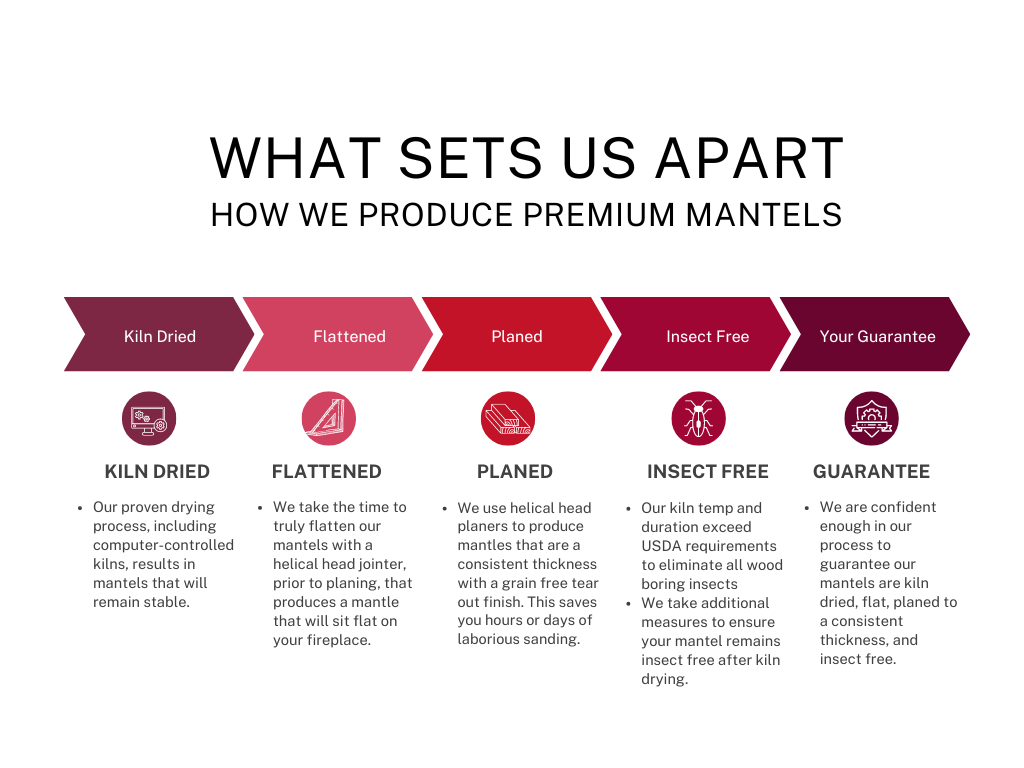FAQs
What sets our Live Edge Slabs apart?
 Our live edge slabs are sawn from large diameter logs that we sustainably harvest from within a 100-mile radius of our mill.
Our live edge slabs are sawn from large diameter logs that we sustainably harvest from within a 100-mile radius of our mill.
After sawing, the slabs are placed on stickers at very close intervals and stored in one of our covered buildings to begin the slow and controlled air-drying process. This process typically takes 2-4 years depending on the thickness of the material. After air drying, slabs are placed in one of our 3 computer-controlled kilns and carefully dried down to a moisture content of 6-8%.
After kiln drying, we first accurately flatten one face of the slab and then flip it over and plane the slab to a consistent thickness. This step is performed with our custom-made, 100” wide jointer/planer. Our planer leaves a surface finish that allows you to start hand sanding with 120 grit.
After flattening and planing, slabs are kept in humidity-controlled buildings to maintain the desired moisture content of 6-8%, which is ideal for interior applications throughout the country.
This process is not the fastest, and it is not the cheapest, but it has proven to produce the highest quality live edge slabs available on the market. We are confident enough in our process that we guarantee that our slabs are truly dry, flat, planed to a consistent thickness, and insect free.
What sets our Lumber apart?
 Our lumber is sawn from high-grade logs that are sustainably harvested from within a 100 miles of our mill.
Our lumber is sawn from high-grade logs that are sustainably harvested from within a 100 miles of our mill.
Behind the sawmill, we use an edger and a crosscut saw to cut out defects that are unsatisfactory to our customers. After defecting, it is placed on stickers at very close intervals and stored in one of our covered buildings to begin the slow and controlled air-drying process. This process typically takes 1-2 years depending on the thickness of the material. After air drying, the lumber is placed in one of our 3 computer-controlled kilns and carefully dried down to a moisture content of 6-8%.
After kiln drying, we use a 36”automatic fed jointer to first flatten one face and then a 36” Whitney planer to plane to thickness. Both machines utilize carbide helical heads. The lumber is hit or miss planed and 4/4 is sold at 15/16” and 8/4 is sold at 1 15/16”.
After flattening and planing, lumber is kept in humidity-controlled buildings to maintain a moisture content of 6-8%.
This process is not the fastest, and it is not the cheapest, but it has proven to produce the highest quality lumber available on the market. We are confident enough in our process that we guarantee that our lumber is truly dry, flat, planed to a consistent thickness, and insect free.
What sets our Mantels apart?
 Our mantles are sawn from logs that are sustainably harvested from within 100 miles of our mill.
Our mantles are sawn from logs that are sustainably harvested from within 100 miles of our mill.
We generally cut mantles about 6” thick and 6-8 ft long. Our live edge mantles have a straight edge in the back and a live edge on the front. Our milled edge mantles have straight edges on both the front and the back edge. After sawing, mantles are placed on stickers at very close intervals and stored in one of our covered buildings to begin the slow and controlled air-drying process. This process typically takes 1-2 years. After air drying, the mantles are placed in one of our 3 computer-controlled kilns and are dried for several months.
After kiln drying, we use a 36”automatic fed jointer to first flatten one face and then a 36” Whitney planer to plane the mantles to a consistent thickness. Both machines utilize carbide helical heads. After flattening and planing, we use a jointer to straighten the back edge and then crosscut the ends square. At this point, the mantles are ready for final sanding starting with 120 grit.
This process is not the fastest, and it is not the cheapest, but it has proven to produce the highest quality mantles available on the market. We are confident enough in our process that we guarantee that our mantles are dry, flat, planed to a consistent thickness, and insect free.
Do you offer a Guarantee?
Yes. We guarantee that our live edge slabs and lumber are truly dry, flattened, planed to a consistent thickness, and insect- free.

We guarantee our materials are truly dry. With a long air-drying period (typically 1-4 years) followed by gentle kiln drying in our onsite computer-controlled kilns, we produce material with a 6-8% MC throughout the entire thickness. This process creates a truly dry, stable product free from internal stress. Competitors advertise other methods that can dry wood in a fraction of the time. We have tested their processes, and they cannot match the quality that our slow and steady process produces.
We guarantee our materials are truly flat and of a consistent thickness. With our specialized machinery, we take the time to accurately flatten one face prior to planing our material to a consistent thickness. Our machines leave a surface finish that allows you to start sanding with 120 grit, saving you hours of laborious sanding.
We guarantee our materials are insect-free. Until it happens, most people don’t think about wood-boring insects in finished pieces. In addition to properly kiln drying, we take additional measures to ensure that our wood products remain insect-free for years to come. This step can give you peace of mind, knowing you will never encounter this unforeseen disaster.
With our guarantee, you can be confident that our materials will perform to the highest standards, no matter what your project entails.
Are your slabs surfaced?
Yes. We have a full suite of machines including our custom-built, 100”-wide jointer planer that uses helical carbide heads to precisely flatten one face and then plane to a consistent thickness. The surface finish directly off of our planer allows you to start the final hand sanding process with 120 grit sandpaper. This saves you hours, or days, of laborious sanding and provides you with a product that is truly flat and a consistent thickness.
Is your wood kiln dried?
Yes. Our computer-controlled kilns dry wood to a consistent moisture content of 6-8% throughout the entire thickness. This ensures the wood is stable and insect free. Additionally, wood is properly stored in our climate-controlled warehouse to maintain the correct moisture content.
Is your wood insect free?
Yes. Our kiln temperatures and durations exceed USDA requirements to eliminate all wood boring insects and we take additional measures to ensure your products remain insect free after kiln drying.
Do you ship?
Yes. We ship nationwide in the U.S. and can ship worldwide to select countries. Please contact us first about international shipping.
What is the cost for shipping?
The cost for shipping generally ranges between $300-$900 depending on weight, size, and distance. The cost includes building a heavy-duty, custom crate to protect your piece while in transit.

How long does it take to ship?
Your order will typically arrive within 1-2 weeks from placing the order.
How can I be prepared to receive my shipment?
Many of our products are large and heavy which require extra handling consideration.
All freight shipments are equipped with liftgate service to assist with getting the crate from the truck to the ground. This will handle slabs up to 80 inches in length and 42 inches in width.
If your crate exceeds the dimensions of the liftgate, the receiver is responsible for ensuring the crate can be unloaded out of the truck. This can include a forklift, loading dock, or manpower.
Please call the Berdoll Sawmill office at (512) 629-3625 if you have questions or need assistance.

Why are slabs so expensive?
Price is what you pay, value is what you get.
First, it takes a considerable amount of equipment to harvest and transport large diameter logs to the sawmill. Then it takes large, expensive machinery to expertly cut logs into slabs while maximizing the natural beauty and grain of the material. Next, it takes years to air dry the slabs and months to kiln dry them to ensure they are the correct moisture content and insect free. Additionally, our slabs are truly surfaced flat and planed to a consistent thickness with our 100" wide jointer planer. The planer utilizes helical heads to produce a surface that allows you to start sanding with 120 grit sandpaper. All of these processes take time, energy, and money, but you will be purchasing a product of unsurpassed quality.
What species do you sell?
We specialize in species that grow native to the Central Texas area. These generally are Pecan, Mesquite, Black Walnut, Long Leaf Pine, and occasionally a few other species such as Cedar, Sycamore, Cedar Elm, Post oak, Texas Ebony, Escarpment Cherry, etc.
Do you sell cedar?
We do not sell large volumes of dimensional cedar lumber, but we do provide landscape architects with cedar for outside applications.
Do you buy logs?
Yes. We do purchase hardwood logs, but we are very selective. Starting with high-quality logs is the first step in producing exceptional live edge slabs and lumber.
Do you mill Live Oak?
Live Oak, with its unique characteristics, presents one of the most formidable challenges in the world of woodworking. Unlike most hardwoods, Live Oak features an interlocking grain, with wood cells that grow in a spiral pattern reminiscent of DNA. This distinctive grain structure not only adds to the wood's toughness but also makes sawing the log into slabs or lumber a daunting task. In fact, when sawing Live Oak, the blade dulls 5-10 times faster than when sawing other hardwoods.
Live Oak begins to dry as soon as it is exposed to air, which will cause cracks and shrinkage. As the wood continues to dry, it "rips" itself apart. It will warp, twist, cup, and bow. Drying the wood is a very long process, typically taking at least one year per inch of thickness before considering placing it in a kiln.
Trying to flatten and plane the wood can be complicated, even if you end up with well-sawn, well-dried Live Oak. The wood often has so much internal stress that it moves while trying to flatten and plane it.
Live Oak is a beautiful species, but converting a Live Oak log into furniture-grade slabs and lumber is difficult, time-consuming, and very expensive. For these reasons, we generally discourage customers from sawing and drying Live Oak.
Berdoll Sawmill Facilities Tour

